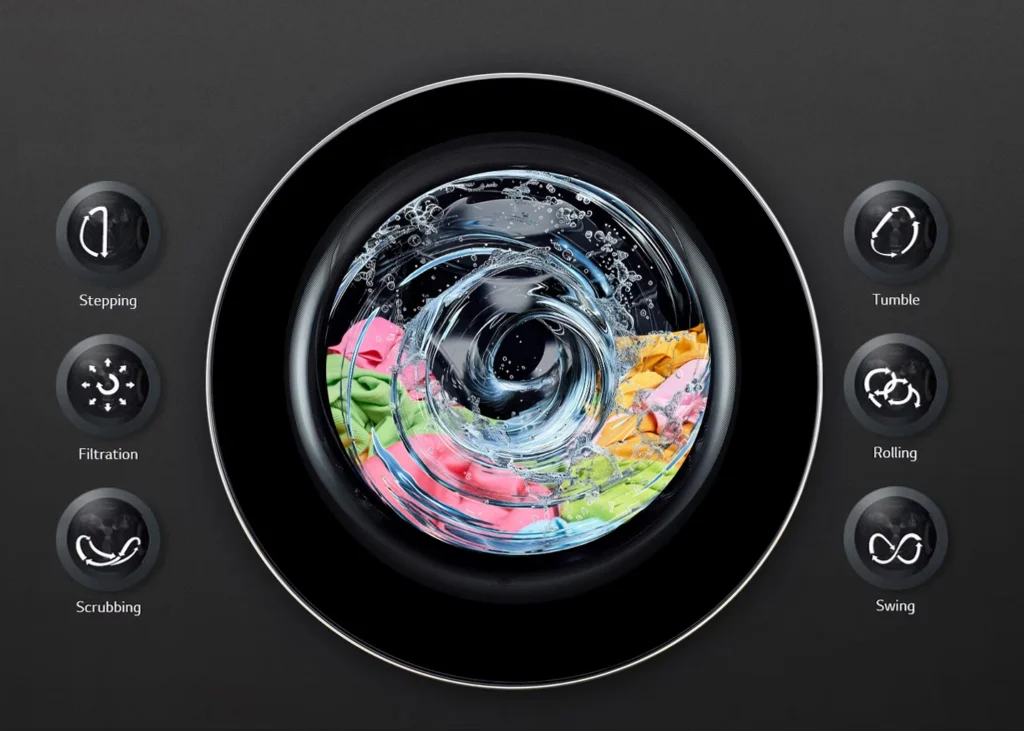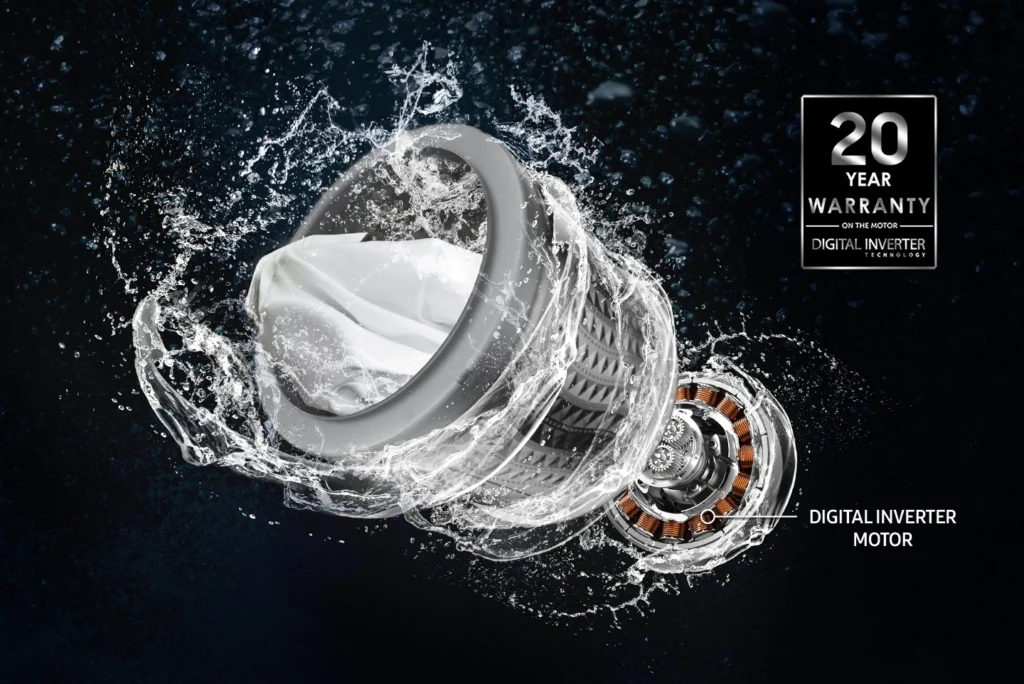When researching which washing machine to buy for your home, you come across terms like ‘Digital Inverter technology,’ ‘Direct Drive Technology,’ Intellisense Inverter Technology.’ and words to similar effect.
We shall go through these aspects in this article. Meanwhile, here is a brief comparison between washing machines with inverter technology and non-inverter motors. This information should prove helpful to understand the concept and benefits of selecting a washing machine with inverter technology.
Inverter vs Non-Inverter Washing Machine
| Inverter Washing machines | Non-inverter washing machines |
|---|---|
| These machines use brushless motors and do not have pulleys, belts, or gears. | It uses brushes to transfer energy and comes with parts like pulleys and belts. |
| The inverter motors are bulkier. | The non-inverter motors are comparatively lighter. |
| These machines have sensors to detect load capacity. Hence, it enables them to vary power consumption. | Due to the absence of sensors, the non-inverter washing machines consume the same power irrespective of the load. |
| Inverter washing machines do not make much noise. | In comparison, the non-inverter washing machines make more noise. |
| These appliances are more durable. Hence, they get extended warranties, thereby reducing overall maintenance costs. | The non-inverter washing machines are less durable. Therefore, they get reduced warranties, resulting in increased maintenance costs over their lifespan. |
| Compared to non-inverter washing machines, these appliances are expensive. | The non-inverter washing machines cost less than their inverter counterparts. |
Today, almost 80% of the washing machines come with inverter motors.
Inverter Technology vs Non-Inverter Technology
First of all, we clarify that inverter technology in washing machines has nothing to do with your home inverter system.
The primary difference between an inverter and a non-inverter washing machine is in the motor’s functioning. The electric current flows to the rotor through brushes that create a magnetic field to set the motor windings into motion in the conventional motor.

The inverter motor is different because it does not have any friction-causing components like brushes. You can refer to an inverter as a frequency converter because it converts AC into DC and then generates AC with the desired frequency level. Therefore, it adjusts with the speed and frequency modes of the wash drum.
Thus, we can infer that inverter motors vary the machine’s speed to consume less energy. It makes sense to have an inverter motor in a washing machine as we do not have the same load every day.
The conventional motors work at the same speed irrespective of the load inside the washing machine. Therefore, they consume the same amount of power even if the load is less. The inverter motor does away with this problem. These washing machines come equipped with sensors to determine the load. It enables them to decide on the quantity of water and varies the motor’s speed accordingly to deliver the job by consuming less power.

Besides, inverter motors do not have components like belts and pulleys like the conventional non-inverter motors do. Therefore, the inverter washing machines make less noise while functioning.
Different technologies used by manufacturers
LG has introduced a new technology, Direct Drive technology, where the wash drum is directly connected to the motor. This outer rotor-type BLDC motor connects to the washing tub without using a pulley or a belt.

This technology improves washing efficiency by allowing precise control of the washing operations. As this technology ensures accurate alignment between the motor and the washing tub, there is less vibration and minimum noise. Compared to conventional washing machines, this technology enhances the lifespan of inverter washing machines.
Samsung’s Digital Inverter technology is similar to LG’s Direct Drive technology as it connects the motor directly to the washing drum. However, the technology uses strong magnets to provide durability and power. As a result, these washing machines consume up to 40% less power and make less noise. In addition, this technology senses the washing load and helps optimize performance levels by saving water and electricity.

Whirlpool offers a similar technology and names it the 6th Sense Soft Move technology. This feature intelligently senses the washing load and adapts the drum rotation speed to minimize friction and maximize washing performance. In addition, the Intellisense inverter motor works silently with minimum friction and vibration to provide an ultimate washing experience.
Though we have different names with minor differences in functioning, the overall features of the technology are the same. The primary advantage of using inverter motors in washing machines is maximizing energy efficiency, ensuring optimum water usage, and making less noise. All these factors contribute towards a longer lifespan for the washing machine.

Advantages of Inverter Technology in Washing machines
- Inverter washing machines use brushless motors that can deliver efficient performances. In addition, as the sensors present in the motor identify the washing load, it helps keep power consumption under check.
- The reduced power consumption helps to minimize your electricity bill considerably and thus, result in maximum savings.
- The absence of pulleys, belts, and gears in these machines reduces friction. Besides, it minimizes the wear and tear of the machine parts to reduce overall maintenance costs.
- As there is less friction, the noise levels of inverter washing machines are less than the non-inverter washing machines.
- Since inverter washing machines are more durable, the OEMs offer extended warranties on such machines.
Drawbacks of Inverter washing machines
- The primary drawback of an inverter machine is its higher cost than its non-inverter counterpart. However, you can replenish the additional initial outflow by savings in water consumption and energy.
Conclusion
The energy efficiency of washing machines is reflected in the BEE Star Ratings. The ratings account for various factors like water consumption, load, usage, number of wash cycles, etc. The higher the rating, the better is the washing machine’s efficiency.
